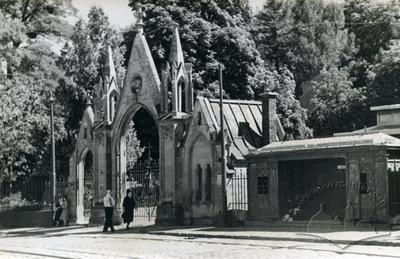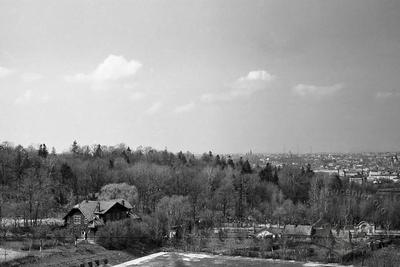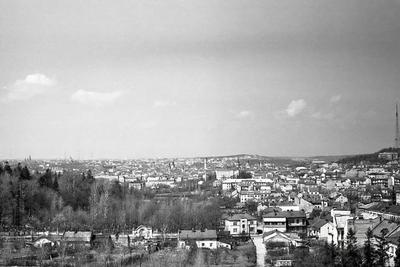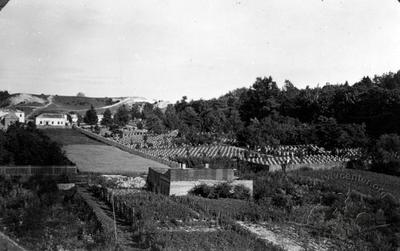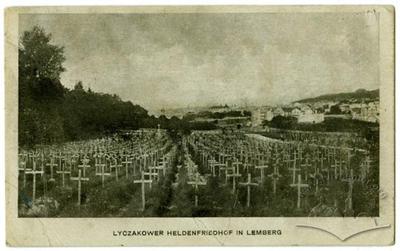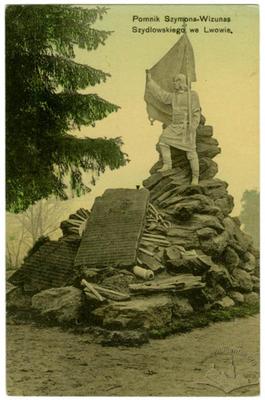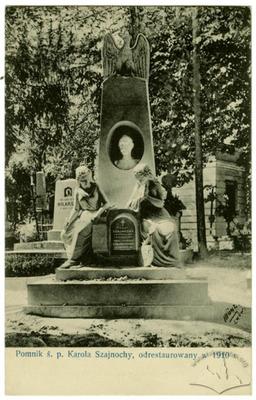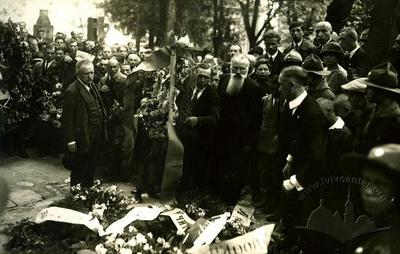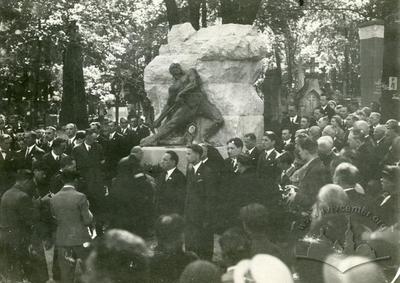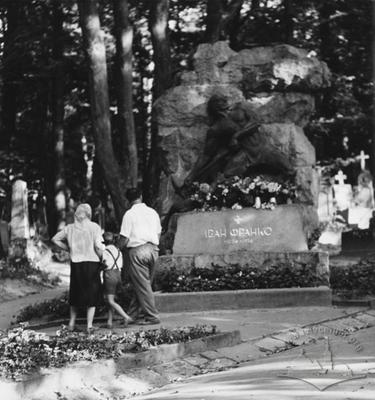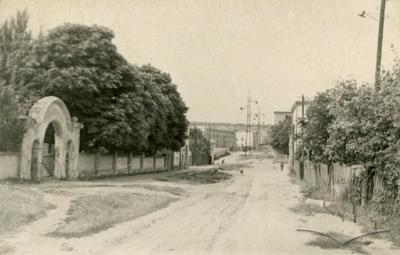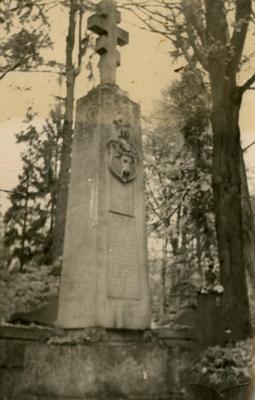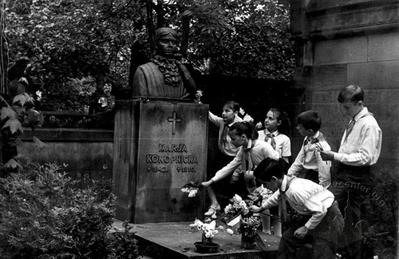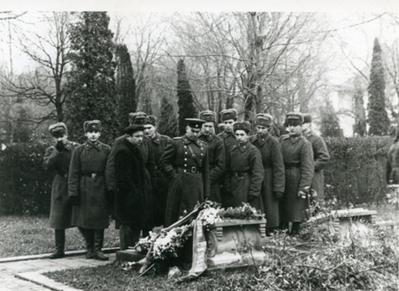Vul. Mechnikova – Lychakivskyi (Lychakiv) cemetery ID: 939
Lychakivsky (Lychakiv) cemetery is situated close to Mechnykova street; its territory occupies the Lychakiv plateau and its vicinities. As for today, this is the oldest preserved cemetery in Lviv which was officially opened in 1786. It is one of the best known European necropolises containing a lot of artistic monuments. The cemetery has been declared a historical, archaeological and artistic monument of national significance. There one can see the graves of many prominent persons, military burial places belonging to the times of the First and Second World Wars etc.
Story
Lychakivsky cemetery is the oldest out-of-town cemetery of Lviv that has been preserved till our days. Its location was generally known as “the sands” (pisky). The first concise records of this cemetery date back to approximately 1567 when plague victims were buried there. Nevertheless, the oldest preserved monuments are dated to the late eighteenth century.
Officially, Lychakivsky cemetery was opened in the end of 1786 after cemeteries situated near churches had been abolished under the Emperor’s decrees. At that time it was located outside the town and was meant for those who lived in the town’s central part and in the suburb named Lychakiv. Chiefly, rich Lviv citizens were buried there while the poor were buried in Stryisky cemetery and later in that of Yaniv.
Lychakivsky cemetery occupied much less territory initially than it does today. In the first years of its official existence it was situated on the top of the hill where a wooden pavilion stood in the eighteenth century (it still existed in the early twentieth century). The cemetery occupied then the territory of current fields 7, 9, 10, 14, where several ancient gravestones still can be seen today.
Due to its location some distance away from the regular town housing, the territory of Lychakivsky cemetery could be expanded. In 1804 and 1808 some adjoining plots were purchased to enlarge this territory. The cemetery was not taken care of properly at the outset. However, during the next expansion in 1856 Karl Bauer, a university botanist, was invited to put it in order; in cooperation with Tytus Tchórzewski, the cemetery manager, he arranged the territory, laid out alleys and paths and made the cemetery territory look like a park.
As for today, Lychakivsky cemetery is one of the best known necropolises in Europe. According to the resolution adopted by the Lviv City Council on 10 July 1990, the territory of Lychakivsky cemetery was declared a historical and cultural reserve of local significance. In 1991 the military graveyard of Pahorb Slavy (“The Hill of Glory”) was joined to it.
Lychakivsky cemetery is the place of burial of a great number of prominent persons. In field 45, located in the north-eastern part of the cemetery, Mykola Shrah (d. 1970) is buried, who was the deputy chairman of the Ukrainian Central Council (Centralna Rada) and a professor of Lviv Polytechnic; Olena Stepanivna (d. 1963), a khorunzha (junior officer) of the Ukrainian Sich Riflemen and Ukrainian Galician Army, a historian and writer, is buried in field 64; f. Avrelian Andrukhovych (d. 1942), f. R. Lukan (d. 1943) and f. T. Kostruba (d. 1943), who all were historians of the Church, are buried nearby. The only grave, which has remained from the military cemetery of the Austro-Hungarian army which was destroyed, is located in field 82. Volodymyr Hrebeniak (d. 1915), an archaeologist, anthropologist, and actual member of the Shevchenko Scientific Society, is buried there. In the north-western part of the cemetery the following persons are buried: Stepan Gzhytsky (d. 1967), a biochemist, Myron Zarytsky (d. 1961), a mathematician, Oleksa Novakivsky (d. 1935), a painter, and Volodymyr Shukhevych (d. 1915), an ethnographer, in field 59; Vasyl Lukych (Levytsky) (d. 1938), a writer, and Illia Kokorudz (d. 1933), the academic gymnasium headmaster, in field 60a. Nearby, in field 61, Stefania Gebus-Baranetska (d. 1985), a painter, is buried.
To the left of the main entrance, field 1 is situated, which has been considered a pantheon of distinguished Lviv citizens since the late nineteenth century. Here, in the vault of the Svachynsky family, the grave of Ivan Franko (d. 1916) was initially located; five years later the coffin with his remains was taken to a separate grave where a monument was constructed in 1933. Ukrainian writers Andriy Voloshchak (d. 1973), Volodymyr Gzhytsky (d. 1973), Vasyl Pachovsky (d. 1942), Hryhoriy Tiutiunnyk (d. 1961), Petro Karmansky (d. 1956), Petro Kozlaniuk (d. 1965), Petro Inhulsky (d. 1976), Mykhailo Yatskiv (d. 1961), Stepan-Yuriy Masliak (d. 1960), painters Ivan Trush (d. 1911), Osyp Kurylas (d. 1951), V. Savyn (d. 1971), sculptor Ivan Severa (d. 1971), public figures and politicians Omelian Ohonovsky (d. 1894), O. Markov (d. 1909), Roman Sushko (d. 1944), Olha Tsipanovska (d. 1941), Mykola Holubets (d. 1942), academician Mykhailo Vozniak (d. 1954), professor Stepan Shchurat (d. 1990), architects Ivan Bahensky (d. 1967), Adam Kuryllo (d. 1980), Henrikh Shvanetsky-Vinetsky (d. 1965) are buried in field 1. The graves of historian Ivan Krypiakevych (d. 1967) and writer Iryna Vilde (d. 1982) are situated in adjoining field 59.
Lower from the monument of Juliusz Ordon, there are the graves of Antoniy Dursky (d. 1908), the youth sport and educational organization Sokil founder; Stanisław Szczepanowski (d. 1900), a pioneer of oil industry in Galicia; Lviv presidents Michał Michalski (d. 1907), Tadeusz Rutowski (d. 1918) and Godzimir Małachowski (d. 1908). Graves of some prominent figures of Polish culture, art and public life are situated nearby. Polish writer Maria Konopnicka (d. 1910) and Gabrieła Zapolska (d. 1921), poets Władysław Bełza (d. 1913) and Seweryn Goszczyński (d. 1876), architect Zygmunt Gorgolewski (d. 1903), historian O. Czołowski (d. 1944), professor of Lviv Polytechnic Karol Skibiński (d. 1922) and a lot of others are buried there.
Yaroslav Halan (d. 1949), a writer and essayist, and some other figures of the Soviet times, namely Kuzma Pelekhaty (d. 1952), Semen Stefanyk (d. 1981), Mykola Hnydiuk (d. 1976), B. Dudykevych (d. 1972), Yuriy Melnychuk (d. 1963), rector of Lviv Polytechnic and Lviv Ivan Franko State University Mykola Maksymovych (d. 1981) and his wife Maria Kikh (d. 1979), orthopaedist I. Zaichenko (d. 1964), generals Vasyl Bisiarin (d. 1969) and Mykola Abashyn (d. 1969), as well as some others were buried in field 1 in the postwar period. Nearby, in field 3, there is the burial vault and graves of the Barvinsky family; in particular, Oleksandr Barvinsky (d. 1927), a prominent educator and literary man, historian, the Austrian parliament member, and his son, Vasyl Barvinsky (d. 1964), a well-known composer and GULAG prisoner, are buried there. To the right of the Barvinskys’ vault Yaroslav Kulachkivsky (d. 1919) is buried, who was the founder and director of the Mutual Commitments Society and of the Dnister bank. The grave of Ivan Verkhratsky (d. 1919), a prominent figure of Ukrainian culture, is located deeper in the field. Y. Oleksiy (d. 1934), an officer of the Ukrainian Galician Army, and composers Stanislav Liudkevych (d. 1979) and Anatoliy Kos-Anatolsky (d. 1983) are buried in the same field.
Not far from there, in field 4, there is the grave of Olha Khoruzhynska (d. 1941), Ivan Franko’s wife, as well as those of Solomia Krushelnytska, a well-known singer, and some members of her family, actors Vasyl Yaremenko (d. 1976) and Ivan Rubchak (d. 1952), musician T. Shukhevych (d. 1951), writer Ivan Beley (d. 1921), physicist Vasyl Miliyanchuk (d. 1958), painters Leopold Levytsky, Z. Masliak (d. 1984), Abel Maria Perier (d. 1881). The Neo-Gothic gravestones of Armenian archbishops Isaak Isakowicz (d. 1901) and Samuel Stefanowicz (d. 1858) are also located in this field.
Graves of some distinguished Ukrainians are located in field 5. Ivan Vahylevych (d. 1866), a member of the Ruthenian Triad; the Peoples’ Trade directors A. Nechay (d. 1916) and Vasyl Nahirny (d. 1921); Adam Kocko (d. 1910), a leader of Ukrainian student movement; the Prosvita Society chairman Ivan Kyveliuk (d. 1922); writers Mariyka Pidhirianka (d. 1968) and Kostiantyna Malytska (d. 1947); physician Marian Panchyshyn (d. 1943); academician Volodymyr Hnatiuk (d. 1926); historian Anton Petrushevych (d. 1913); painter Antin Manastyrsky (d. 1969), and a lot of others are buried there. Painter Artur Grottger and sculptor Julian Markowski (d. 1903), who both were prominent figures of Polish culture, are buried there as well. In the same field, there is the grave of Józef Torosewicz (d. 1869), a philanthropist who took care of Armenian orphans; the monument on his grave was made by sculptor Edmund Jaskulski. Not far from there, in field 11, Anton Schimser (d. 1838) and Johann Schimser (d. 1856) are buried.
In the fields with old graves, some prominent figures of Ukrainian culture are also buried. Among them, the following persons can be mentioned: Anton Pavetsky (d. 1889), the first Ukrainian newspaper Zoria Halytska editor (field 7); Yosyp Stadnyk (d. 1954), an actor, the Ruska Besida theatre director (field 8); O. Partytsky (d. 1895), an educator, the Zoria newspaper editor; f. chamberlain O. Pohoretsky (d. 1956), an active figure of the November Uprising of 1918 and the Austrian parliament member (field 27); Y. Medvetsky (d. 1918), a rector of Lviv Polytechnic (field 19); architect I. Bazarnyk (d. 1985) (field 7).
In the southern part of the cemetery, along the main alley and in the adjoining fields (13, 21, 22, 51, 52, 53, 54, 69, 71, 72, 73, 76, 78) the graves of some distinguished Lviv citizens are located. Writers Osyp Turiansky (d. 1915), Antin Lototsky (d. 1949), Yulian Opilsky (d. 1937), Mykhailo Pavlyk (d. 1915), Mykhailo Rudnytsky (d. 1975), Milena Lysiak-Rudnytska (d. 1976); scholars and scientists Maksym Muzyka (d. 1972), Ilarion Svientsitsky (d. 1956), Vasyl Levytsky (d. 1956), Volodymyr Okhrymovych (d. 1931), Julian Tselevych (d. 1892), Filaret Kolessa (d. 1947); architects Ivan Levynsky (Jan Lewiński, d. 1956), Julian Zachariewicz (d. 1898); historians Denis Zubrytsky (d. 1862), Isydor Sharanevych (d. 1901), Myron Korduba (d. 1947); composers Anatol Vakhnianyn (d. 1908), Volodymyr Ivasiuk (d. 1979); painters Olena Kulchytska (d. 1941), Yaroslava Muzyka (d. 1974), Pavlo Kovzhun (d. 1939) are buried there.
The symbolic grave of writer Anton Krushelnytsky (d. 1937) and his children, who were killed by the Soviet regime in 1934-1937, is located in field 23. The memorial plaque of lawyer Volodymyr Starosolsky (d. 1942) and his wife Daria (d. 1941) can be seen in field 59. The Levytsky family vault, where Lev Levytsky (d. 1937), a lawyer and public figure, his daughter Halyna (d. 1949), a talented pianist, Ivan Krushelnytsky’s wife, and Yulian-Yuriy Dorosh (d. 1982), one of the first filmmakers of Galicia, are buried, is situated nearby.
Well-known sculptors Antoni Popiel (d. 1910) and Leonard Marconi (d. 1928) are buried in field 57; the graves of Franciszek Jaworski (d. 1914) and Bogdan Janusz (d. 1930), Lviv researchers, are located in field 13.
Architecture
The cemetery area is over 42 hectares; approximately 300 thousand graves are located in its 86 fields. There are over 2 thousand burial vaults in the cemetery; about 500 sculptures and reliefs are installed on the graves.The oldest preserved gravestones date back to the years 1787 and 1797. The oldest burial places of Lychakiv, which have been preserved, are situated in fields 2, 6, 7, 8, 9, 10, 14. In particular, the burial vault of the Dunin-Borkovsky family (1812), which is decorated with sculptures made by Hartman Witwer and was restored in the late 1990s, is located in field 6. Witwer is also the author of the monuments on the graves of Juliana Siewitlich-Schragner (d. 1809) and Josef Schabinger (d. 1808) in field 10 and on the graves of M. Poninska-Kalinowska (d. 1797) and S. Nowicki in field 7.
The main entrance to the cemetery is from Mechnykova street. Two Neo-Gothic gates were built there in 1875 and 1901. The right gate led to the so-called rondo with the graves of the most distinguished Lviv citizens situated around it. Patriotic manifestations were held there. Near the great rondo of Lychakivsky cemetery the Bachevsky family vault is situated as well as five other vaults belonging to the following families of Lviv citizens: Kszeczunowicz and Suchodolski, Kisielki, Molędzinski, Adamski, Morowski and Łodyński. On the whole, there are 21 burial vaults of Lviv aristocratic families in Lychakivsky cemetery. The 22nd vault, belonging once to count Dzieduszycki’s family and located in field 73, was destroyed by artillery fire in July of 1944.
A whole constellation of sculptors and architects were the authors of the most valuable monuments of Lychakivsky cemetery. This constellation consisted of Hartman Witwer, Antonius, Johann and Leopold Schimser, Paul Eutele, Abel Maria Perier, Cyprian Godebski, Parys Filippi, Julian Markowski, Antoni Kurzawa, Tadeusz Barącz, Tomasz Dykas, Stanisław Lewandowski, Leonard Marconi, Hryhoriy Kuznevych, Tadeusz Błotnicki, Witold Rawski, Edmund Jaskulski, Stanisław Kazimierz Ostrowski, Luna Drexler. Monuments in the Neo-Classicist, Empire, Eclectic, Secession (Art Nouveau), and Art Deco styles, made by these masters, have been preserved in Lychakiv.
Three-figure sculpture compositions were made by Anton Schimser on the graves of the Breiers, Trenkls, and Weigls, as well as on that of Julianna Nefater (Schabinger) in field 10; he is also the author of an angel’s of death figure on the grave of Maria Catherine de Chaudoir (d. 1821) in field 2, the sarcophagus of Joanna Baghofwund in field 14 and that of the Hausner family in field 8, the monument to Franz von Hauer (d. 1822), a governor of Galicia, in field 7. In the Leosia gravestone in field 2 the characteristic features of Anton Schimser’s manner can be seen too. His brother, Johann Schimser, made the monuments on the graves of M. Bauer and M. Schock in field 5, the Manuhewiczs in field 14, A. Strańska and E. Ilski in field 15 as well as a lot of others.
Paul Eutele’s Lychakiv patrimony numbers 60 works. The best of them are as follows: the monument to Anton Schimser in field 11, the grave of the Iwanowicz family in field 2, the grave of the Obłoczyński sisters in field 50, the monument to Anton Tarnowski in field 14, the gravestone of the Saravelli couple in field 7.
A monument to Juliusz Ordon, a Polish rebel and a hero of the defense of Warsaw in 1831, was erected in field 1 by Julian Markowski’s company under a project drawn up by Tadeusz Barącz in 1896. The erection of this monument made the field look like a pantheon. In this field, there is also one of the best gravestones of the interwar period, the burial vault of the Zakrejs and Truszkowski families (sculptors Jan Nalborczyk and Bronisław Sołtys).
Between the chapels of the Adamski and Baczewski families, one of the main alleys of the cemetery begins which embraces the whole territory of the cemetery and comes back to the entrance near the monument to Seweryn Goszczyński. At the beginning of this alley, in fields 3, 4, and 5 as well as in some adjoining fields, a Ukrainian memorial of Lychakiv was created in the twentieth century. A monument to Ukrainian writer Ivan Franko was erected here in 1933 (sculptor Serhiy Lytvynenko). On the opposite side, a monument to Markiyan Shashkevych (d. 1843), the founder of new Ukrainian literature in Galicia and a member of the Ruthenian Triad, is situated (Henryk Perier’s workshop), as well as a monument to Volodymyr Barvinsky, a writer, essayist and public figure (sculptor Stanisław Lewandowski).
To the left of field 11, in the place where the main alley begins, one can see a monument to presbyter Havryil Kostelnyk (d. 1948) and the burial vault of the St. George’s chapter, where, among others, metropolitans Spyrydon Lytvynovych (d. 1869), Hryhoriy Yakhymovych (d. 1863) and Yulian Sas-Kuilovsky (d. 1900) are buried.
The poetic gravestone to Józefa Markowska in the form of a sleeping woman, made by sculptor Julian Markowski in 1887, decorates field 69. The monumental “Vault of Russian journalists”, where some Galician Russophilic writers and journalists are buried, is situated in field 72. The memorial “Thalerhof cross”, a symbolic grave of the 1914-1918 Austrian repressions victims who passed through Thalerhof, the first concentration camp for civilian population in the world, is located in field 60.
Till the 1990s, there was a modest nameless memorial sign, three crosses on a common grave with an inscription reading “Eternal memory be to them”, in the beginning of field 82. The executed prisoners of the prison number 1 on Lontskoho street were buried in this common grave. In 1995 a new monument under a design by Hryhoriy Lupiy was installed there as well as a memorial plaque. A bit lower from field 82, there is the Riflemen’s Cross stylized as a birch tree. Somewhere in this place, the soldiers and officers of the Ukrainian Galician Army, killed in the Ukrainian-Polish war of 1918-1919, were buried. The cross was placed there on the initiative of the Lviv Memorial organization in 1989. Those executed in the prison number 2 on Zamarstynivska street were buried in a grave in the prison yard. This grave was razed to the ground in the postwar period. In 1990 the remains of the murdered prisoners were exhumed; four years later, in 1994, they were reburied on a free place at the military memorial on Mechnykova street.
In July of 1944, in the northern part of Lychakivsky cemetery, in place of the so-called “Bondar’s vegetable gardens”, a Soviet military cemetery was arranged for the soldiers of the Red Army and the NKVD units who were killed in battle for Lviv and in punitive expeditions against the UPA (Ukrainian Insurgent Army) or died from wounds in military hospitals. In general, 3491 persons were buried there in 1944-1950. In 1974 the military cemetery, according to a reconstruction project drawn up by architects Andriy Shuliar and Vasyl Kamenshchyk and sculptor V. Boyko, was turned into the Soldiers’ Memorial of the Armed Forces of the USSR. Separate graves were then exhumed; the remains of the killed soldiers were reburied on both sides of the main alley under red and black granite slabs. There are inscriptions with last names, chiefly without dates, on the slabs.
Lychakivsky cemetery includes two more little military cemeteries arranged in the time when Lviv belonged to Austria. The first one is a cemetery of the veterans of the Polish armed uprising against Russia in 1830-1831; it is located in field 71 which occupies an area of 5 ares. 47 participants of the uprising were buried there in 1881-1916. 146 their comrades-in-arms were buried in other places of Lychakivsky cemetery. After the January Uprising of 1863-1864 against Tsarist Russia had been defeated, the veterans created a number of organizations that took care of its participants. In particular, on the initiative of the Society of mutual help for the participants of the 1863-1864 Polish Uprising, in the second half of the 1890s some place was allotted by the municipal authorities of Lviv for burying the insurgents (field 40). 230 veterans of this uprising were buried there.
Another memorial, Polish military graves of 1918-1920, is situated in the south-eastern part of Lychakivsky cemetery. The memorial was constructed under the project drawn up by Rudolf Indruch, an assistant of Lviv Polytechnic. This cemetery was considerably damaged during the Second World War and ultimately abolished in the 1970s. The renovation of the cemetery was started in the 1990s.
In field 76 nearby, a memorial of the Ukrainian nation’s liberating struggle is being constructed. The project was drawn up by a group of authors consisting of sculptors Mykola Posikira and Dmytro Krvavych and architect Ihor Havryshkevych.
Related buildings and spaces
People
Abel Maria Karol Perier – a Lviv sculptor; a lot of his works can be seen in Lychakivsky cemetery.
Anatoliy Kos-Anatolsky – a Ukrainian composer, a Peoples’ Artist of Ukraine, a laureate of the T. Shevchenko State Prize of the Ukrainian SSR.
Andriy Shuliar – a Ukrainian architect.
Antin Manastyrsky – a Ukrainian painter and graphic artist.
Anton Pavetsky – the first Ukrainian newspaper Zoria Halytska editor.
Anton Schimser – a Lviv sculptor; a lot of his works can be seen in Lychakivsky cemetery.
Antoni Kurzawa – a sculptor; a lot of his works can be seen in Lychakivsky cemetery.
Artur Grottger – a Polish painter, one of the leading representatives of the Romanticism in Polish art, an illustrator and master of drawing, the author of a cycle of works dedicated to the January Uprising of 1863-1864.
Bronisław Marian Sołtys – a sculptor.
Cyprian Godebski – a sculptor; a lot of his works can be seen in Lychakivsky cemetery.
Denys Zubrytsky (also known as Dionizy Zubrzycki) – a Ukrainian historian, ethnographer and archivist who put in order a number of archives in Lviv.
Dmytro Krvavych – a Ukrainian sculptor and art critic, a laureate of the T. Shevchenko State Prize of the Ukrainian SSR (1972).
Edmund Jaskólski – a sculptor; a lot of his works can be seen in Lychakivsky cemetery.
Emmanuil Mysko – a Lviv sculptor.
Franciszek Jaworski – a Polish historian, journalist, essayist, writer, archivist and collector, one of the most gifted researchers and popularizers of the history of Lviv and other towns of Galicia.
Hartman Witwer – a Lviv sculptor; a lot of his works can be seen in Lychakivsky cemetery.
Hryhoriy Kuznevych – a Ukrainian sculptor; a lot of his works can be seen in Lychakivsky cemetery.
Hryhoriy Lupiy – a distinguished worker of culture of Ukraine, the first director of the Lviv historical and cultural museum and reserve of Lychakivsky Tsvyntar (cemetery).
Hryhoriy Tiutiunnyk – a Ukrainian writer and poet.
Hryhoriy Yakhymovych – the Metropolitan of Halych and Archbishop of Lviv (head of the UGCC) from 1864.
Illia Kokorudz – a professor who promoted the development of Ukrainian school and belonged to Ukrainian societies (Shevchenko Scientific Society, Prosvita, Rusky Klub etc.).
Ivan Bahensky (also known as Jan Bagieński) – a Lviv architect and teacher.
Ivan Franko – a Ukrainian writer, poet, essayist, translator, scholar, public and political figure.
Ivan Krypiakevych – a historian, an academician of the Academy of Sciences of the Ukrainian SSR, the director of the Institute of Social Sciences at the Lviv branch of the Academy of Sciences of the Ukrainian SSR, the author of a number of textbooks on the history of Ukraine.
Ivan Levynsky (also known as Jan Lewiński) – a Ukrainian architect, educator, entrepreneur, public figure.
Ivan Trush – a Ukrainian impressionist painter, master of landscape and portrait, art critic and organizer of artistic life in Galicia.
Ivan Vahylevych – a Greek Catholic priest, a Ukrainian poet, philologist, student of folklore, ethnographer and public figure, a member of the Ruthenian Triad and one of the authors of the Rusalka Dnistrovaya (The Dniester Nymph) almanac.
Jan Juliusz Nalborczyk – a Lviv sculptor and educator.
Johann Baptiste Schimser – a Lviv sculptor; a lot of his works can be seen in Lychakivsky cemetery.
Julian Markowski – sculptor Johann Baptiste Schimser’s grandson, a Lviv sculptor; a lot of his works can be seen in Lychakivsky cemetery.
Julian Oktawian Zachariewicz – a Lviv architect who founded and organized the Lviv architectural school which defined the architectural image of Lviv in the second half of the 19th and in the early 20th centuries.
Juliusz Konstanty Ordon – a participant of the Polish Uprising of 1830-1831, one of the organizer of the defense of Warsaw in 1831, an officer of the Polish army.
Karl Bauer – a university botanist who put in order the cemetery territory in 1856.
Liubomyr Yaremchuk – a Lviv sculptor.
Luka Bihanych – a Lviv sculptor.
Luna Amalia Drexler – a sculptor and painter; a lot of her works can be seen in Lychakivsky cemetery.
Maria Konopnicka – a Polish writer and poetess, novelist, critic of literature and essayist who wrote also for children and youth.
Mariyka Pidhirianka (a pen name of Maria Lenert-Dombrovska) – a Ukrainian poetess who wrote chiefly for children.
Markiyan Shashkevych – the founder of new Ukrainian literature in Galicia, a member of the Ruthenian Triad (Ruska Triitsia).
Mykhailo Yatskiv – a Ukrainian poet, the Young Muse representative.
Mykola Posikira – a Lviv sculptor.
Mykola Shrah – a Ukrainian economist and public and political figure, the deputy chairman of the Ukrainian Central Council (Rada), professor of Lviv Polytechnic.
Myron Zarytsky – a Ukrainian mathematician, professor of Lviv State University, actual member of the Shevchenko Scientific Society.
Oleksa Novakivsky – a Ukrainian painter and educator.
Oleksandr Barvinsky – a prominent educator and literary man, historian, the Austrian parliament member.
Olena Khoruzhynska – Ivan Franko’s wife.
Olena Stepanivna (Stepaniv) – a khorunzha (junior officer) of the Ukrainian Sich Riflemen and Ukrainian Galician Army, a historian and writer.
Paul Eutele – a Lviv sculptor; a lot of his works can be seen in Lychakivsky cemetery.
Petro Dzyndra – a Lviv sculptor.
Petro Inhulsky – a journalist, essayist, publisher, the Zhovten magazine editor.
Petro Karmansky – a Ukrainian poet and translator, the Young Muse representative.
Petro Kulyk – a sculptor who worked at Lychakivsky cemetery.
Roman Sushko – a military and political figure, a lieutenant of the Ukrainian Sich Riflemen, a co-organizer and colonel of the Sich Riflemen, a regional commandant of the Ukrainian Military Organization, a co-founder of the Organization of Ukrainian Nationalists, the “Sushko’s Legion” commander (his pseudonyms were “Sych”, “Kindrat”).
Rudolf Indruch – an architect, engineer, captain of the Polish army.
Solomia Krushelnytska – a Ukrainian opera singer, educator.
Spyrydon Lytvynovych – the Metropolitan of Halych and Archbishop of Lviv (head of the UGCC) from 1860.
Stanislav Liudkevych – a Ukrainian composer, musicologist, student of folklore, educator, actual member of the Shevchenko Scientific Society.
Stanisław Kazimierz Ostrowski – a modernist sculptor; a lot of his works can be seen in Lychakivsky cemetery.
Stanisław Szczepanowski – a Polish economist, engineer, chemist, oil entrepreneur, public figure, essayist, politician.
Stepan Gzhytsky – a Ukrainian scientist in the field of veterinary medicine, the founder of veterinary biochemistry in Ukraine, doctor of biology, professor, actual member of the Shevchenko Scientific Society.
Tadeusz Błotnicki – a sculptor; a lot of his works can be seen in Lychakivsky cemetery.
Teodozia Bryzh – a sculptor who worked at Lychakivsky cemetery.
Tomasz Dykas – a Polish sculptor; a lot of his works can be seen in Lychakivsky cemetery.
Tytus Tchórzewski – the cemetery manager in 1856.
Valentyn Podolsky – a Lviv sculptor.
Vasyl Barvinsky – Oleksandr Barvinsky’s son, a well-known composer, a GULAG prisoner.
Vasyl Lukych (Levytsky) – a Ukrainian writer and public figure, a publisher and expert in literature, a honourable member of the Prosvita society and an actual member of the Shevchenko Scientific Society.
Vasyl Nahirny – a Ukrainian architect and public figure of the late 19th and early 20th centuries who founded many societies, including the Society for Promotion of Ruthenian Art.
Volodymyr Barvinsky – a Ukrainian public figure, publisher, historian, sociologist, journalist, writer (wrote under the pen names of Vasyl Barvinok, Ryshmydynov etc.), translator.
Volodymyr Gzhytsky – a Ukrainian writer, essayist, translator.
Volodymyr Ivasiuk – a Ukrainian composer and poet, a Hero of Ukraine.
Volodymyr Shukhevych – a Ukrainian public figure, ethnographer, educator and essayist, an actual member of the Shevchenko Scientific Society.
Wincenty Witold Erazm Rawski – an architect, sculptor, restorer, art historian, painter.
Yakiv Chaika – a sculptor who worked at Lychakivsky cemetery.
Yevhen Dzyndra – a sculptor, one of the first masters and the most fruitful authors of memorial plastic art after the Second World War. He was educated by sculptors Andriy Koverko and Jan Nabolczuk and made over 20 original works in Lychakivsky cemetery (the stele on the grave of f. Avrelian Andrukhovych; the gravestone on the grave of professor Ilarion Svientsitsky; the monument on the grave of Mykhailo Yatskiv; the gravestone with a portrait depiction of his brother, composer Volodymyr Dzyndra, etc.).
Yevhen Prokopovych – a sculptor who worked in Lychakivsky cemetery.
Yosyp Stadnyk – an actor, the director of the Ruska besida theatre.
Yulian Sas-Kuilovsky – the Metropolitan of Halych and Archbishop of Lviv (head of the UGCC) from 1899.
Yulian-Yuriy Dorosh – one of the first filmmakers of Galicia.
Interview
Sources
- Medyński, Przewodnik po cmentarzu Łyczakowskim (Lwów, 1937).
- Prendkówna, 150 lat historii cmentarza Łyczakowskiego, Przegląd Krajoznawczy, 1938, №12.
- Dziennik literacki, 1863, №47.
- Dziennik Polski, 1867, №82.
- Ilustrowany przewodnik po Lwowie i powszechnej wystawie krajowej (Lwów, 1894).
- J. Białynia-Chołodecki, Cmentarzyska i groby naszych Bogaterów z lat 1794–1864 na terenie Wschodnej Małopolski (Lwów, 1928).
- J. Białynia-Chołodecki, Żelazna Kompania, Kronika Powszechna, 1913, №48.
- J. Markowski, Cmentarz Łyczakowski (Lwów, 1890).
- J. Wiczkowski, Lwów, jego rozwój i stan kulturalny (Lwów, 1907).
- Kurier Lwowski, 1888.
- Kurjer Lwowski, 1890, №254.
- Kurіer Lwowski, 1886, №174.
- Kurіer Lwowski, 1898, №327.
- M. Baczyńska, Przewodnik po cmentarzach lwowskich Łyczakowskim i Janowskim (Lwów, 1937).
- M. Orłowicz, Ilustrowany przewodnik po Lwowie ze 102 ilustracjami i planem miasta (Lwów–Warszawa: Zjednoczone zakłady kartograficzne i wydawnicze tow. naucz. szkół. średn. i wyż. s. a., 1925).
- M. Rolle, Lwowska Boża rola, Gazeta lwowska, 1930, №256.
- Miasto Lwów w okresie samorządu 1870–1895 (Lwów: Z drukarni W. A. Szyjskiego, 1896).
- S. Nicieja, Łyczaków. Сmentarz Łyczakowski we Lwowie (Wrocław, 1989).
- М. Голубець, Личаківський цвинтар у Львові, Діло, №232, №233.
- М. Голубець, Пантеон Галицької землі, Діло, №236, №237.
- J. Biriulow, Rzeźba lwowska od połowy XVIII wieku do 1939 roku (Warzszawa, 2007).
- S. Schnür-Pepłowski, Obrazy z przeszłości Galicyi i Krakowa (1772–1858), T. II (Lwów, 1896).
- Słownik artystów polskich i obcych w Polsce działających, T. I, II.
Citation
Khrystyna Kharchuk. "Vul. Mechnikova – Lychakivskyi (Lychakiv) cemetery". Lviv Interactive (Center for Urban History 2014). URL: https://lia.lvivcenter.org/en/objects/lychakiv-cemetery/Urban Media Archive Materials
